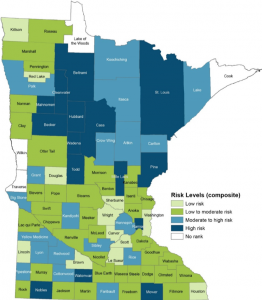
The Institute of Child Development (ICD), in partnership with Wilder Research and the Minnesota Departments of Health, Education, and Human Services, produced the 2018 Minnesota Early Childhood Risk, Reach, and Resilience report, which presents risks to healthy development of children in Minnesota and availability of publicly-funded services to meet their needs. The report was supported by a grant from the Irving Harris Foundation.
For the report, researchers analyzed county-level data for 12 risk indicators in the categories of economic risks, health risks, and family stability risks. For each indicator, each Minnesota county was assigned to one of four risk categories (low, low-to-moderate, moderate-to-high, high), based on a comparison with the state-wide average. Similarly, each county was assigned a reach level (low, low-to-moderate, moderate-to-high, high), demonstrating the proportion of eligible children served by eight publicly-funded programs.
The report found that 51 percent of Minnesota children under age 6 live in moderate-to-high or high-risk counties, up from 46 percent in 2015. The report also found that reach varies significantly by county, with programs serving between 5 percent and 60 percent of eligible children. According to the report, “developmental risk levels are likely to rise without concerted efforts to rectify income inequality and racial inequities and to improve the reach of early childhood health, family support, and education programs.”
The authors wrote that while every risk factor is a concern, no single risk factor determines a child’s developmental trajectory; however, they noted that cumulative risk is the most predictive of adverse outcomes throughout childhood and later in life. They suggested that “[s]upporting and restoring fundamental adaptive relationships and systems for human development are top priorities for promoting competence and resilience in young children and their families.”
According to Elizabeth Carlson, PhD, a senior research associate at ICD and an author of the report, data on child and family strengths and resilience help to provide a more complete picture of early child development in Minnesota. “We hope that this and other reports draw attention to opportunities to make a difference in the health and well-being of Minnesota families,” Carlson says.
To learn more:
- Read the full report
- Explore county-level data



